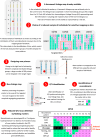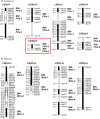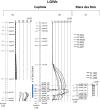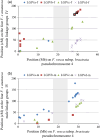Narrowing down the single homoeologous FaPFRU locus controlling flowering in cultivated octoploid strawberry using a selective mapping strategy
- PMID: 27168086
- PMCID: PMC5095798
- DOI: 10.1111/pbi.12574
Narrowing down the single homoeologous FaPFRU locus controlling flowering in cultivated octoploid strawberry using a selective mapping strategy
Abstract
Extending the period of fruit production is a way to substantially increase crop yield in many fruit or ornamental species. In the cultivated octoploid strawberry (Fragaria × ananassa), the most consumed small fruit worldwide, fruit production season can be extended by selecting the perpetual flowering (PF) cultivars. This trait is of considerable interest to growers and to the food industry. Four homoeologous loci controlling a single trait can be expected in such a complex octoploid species. However, we recently showed that the PF trait is under the control of the single dominant FaPFRU locus (J. Exp. Bot., 2013, 64, 1837), making it potentially amenable to marker-assisted selection (MAS). Here, we report the successful use of a strategy, based on a selective mapping using a reduced sample of individuals, to identify nine markers in close linkage to the FaPFRU allelic variant. Thus, this strategy can be used to fine map the target homoeologous loci in other complex polyploid crop species. Recombinant analysis further enabled us to reduce the locus to a region flanked by two markers, Bx083_206 and Bx215_131, corresponding to a 1.1 Mb region in the diploid F. vesca reference genome. This region comprises 234 genes, including 15 flowering associated genes. Among these, the FLOWERING LOCUS T (FT) is known to be a key activator of flowering. The close association between the PF trait and the FaPFRU flanking markers was validated using an additional segregating population and genetic resources. This study lays the foundation for effective and rapid breeding of PF strawberry cultivars by MAS.
Keywords: Fragaria; bin mapping; marker-assisted selection; perpetual flowering; polyploidy.
© 2016 The Authors. Plant Biotechnology Journal published by Society for Experimental Biology and The Association of Applied Biologists and John Wiley & Sons Ltd.
Figures







Similar articles
-
PFRU, a single dominant locus regulates the balance between sexual and asexual plant reproduction in cultivated strawberry.J Exp Bot. 2013 Apr;64(7):1837-48. doi: 10.1093/jxb/ert047. Epub 2013 Apr 3. J Exp Bot. 2013. PMID: 23554259
-
TERMINAL FLOWER1 is a breeding target for a novel everbearing trait and tailored flowering responses in cultivated strawberry (Fragaria × ananassa Duch.).Plant Biotechnol J. 2016 Sep;14(9):1852-61. doi: 10.1111/pbi.12545. Epub 2016 Mar 4. Plant Biotechnol J. 2016. PMID: 26940366 Free PMC article.
-
Discrimination of candidate subgenome-specific loci by linkage map construction with an S1 population of octoploid strawberry (Fragaria × ananassa).BMC Genomics. 2017 May 12;18(1):374. doi: 10.1186/s12864-017-3762-y. BMC Genomics. 2017. PMID: 28499415 Free PMC article.
-
Molecular bases of strawberry fruit quality traits: Advances, challenges, and opportunities.Plant Physiol. 2023 Sep 22;193(2):900-914. doi: 10.1093/plphys/kiad376. Plant Physiol. 2023. PMID: 37399254 Review.
-
Advances in genomics and genome editing for improving strawberry (Fragaria ×ananassa).Front Genet. 2024 Apr 19;15:1382445. doi: 10.3389/fgene.2024.1382445. eCollection 2024. Front Genet. 2024. PMID: 38706796 Free PMC article. Review.
Cited by
-
Comprehensive analysis of the longan transcriptome reveals distinct regulatory programs during the floral transition.BMC Genomics. 2019 Feb 11;20(1):126. doi: 10.1186/s12864-019-5461-3. BMC Genomics. 2019. PMID: 30744552 Free PMC article.
-
FveRGA1, encoding a DELLA protein, negatively regulates runner production in Fragaria vesca.Planta. 2018 Apr;247(4):941-951. doi: 10.1007/s00425-017-2839-9. Epub 2017 Dec 29. Planta. 2018. PMID: 29288326
-
High Resolution Quantitative Trait Locus Mapping and Whole Genome Sequencing Enable the Design of an Anthocyanidin Reductase-Specific Homoeo-Allelic Marker for Fruit Colour Improvement in Octoploid Strawberry (Fragaria × ananassa).Front Plant Sci. 2022 Mar 18;13:869655. doi: 10.3389/fpls.2022.869655. eCollection 2022. Front Plant Sci. 2022. PMID: 35371183 Free PMC article.
-
The FveFT2 florigen/FveTFL1 antiflorigen balance is critical for the control of seasonal flowering in strawberry while FveFT3 modulates axillary meristem fate and yield.New Phytol. 2021 Oct;232(1):372-387. doi: 10.1111/nph.17557. Epub 2021 Jul 16. New Phytol. 2021. PMID: 34131919 Free PMC article.
-
Evidence of epistatic suppression of repeat fruiting in cultivated strawberry.BMC Plant Biol. 2019 Sep 5;19(1):386. doi: 10.1186/s12870-019-1984-7. BMC Plant Biol. 2019. PMID: 31488054 Free PMC article.
References
-
- Albani, M.C. and Coupland, G. (2010) Comparative analysis of flowering in annual and perennial plants. Curr. Top. Dev. Biol. 91, 323–348. - PubMed
-
- Albani, M.C. , Battey, N.H. and Wilkinson, M.J. (2004) The development of ISSR‐derived SCAR markers around the SEASONAL FLOWERING LOCUS (SFL) in Fragaria vesca . Theor. Appl. Genet. 109, 571–579. - PubMed
-
- Basten, C.J. , Weir, B.S. and Zeng, Z.‐B. (1997) QTL Cartographer: A Reference Manual and Tutorial for QTL Mapping. Raleigh, NC: Dep. Stat. North Carolina State Univ.
Publication types
MeSH terms
Substances
LinkOut - more resources
Full Text Sources
Other Literature Sources
Molecular Biology Databases
Miscellaneous

